Effect of Teleconnection Patterns on the Formation of Potential Ecological Flow Variables in Lowland Rivers
Abstract
:1. Introduction
2. Study Area and Data
| No. | River | WGS | Catchment Area (km2) | Qannual of 1961–2020 (m3/s) | qannual (l/s × km2) | Q30 of 1961–2020 (m3/s) | q30 (l/s × km2) | Feeding Source * |
|---|---|---|---|---|---|---|---|---|
| 1. | Nemunas | Druskininkai | 37,382.3 | 202 | 5.4 | 112 | 3.0 | G-sr |
| 2. | Nemunas | Nemajūnai | 42,869.0 | 247 | 5.7 | 142 | 3.3 | G-sr |
| 3. | Nemunas | Smalininkai | 81,129.7 | 493 | 6.1 | 268 | 3.3 | G-sr |
| 4. | Merkys | Puvočiai | 4296.9 | 31.6 | 7.4 | 21.8 | 5.1 | G-sr |
| 5. | Ūla | Zervynos | 679.0 | 4.82 | 7.1 | 2.93 | 4.3 | G-sr |
| 6. | Žeimena | Pabradė | 2595.4 | 20.3 | 7.8 | 12.1 | 4.7 | G-sr |
| 7. | Verknė | Verbyliškės | 694.3 | 5.00 | 7.2 | 2.16 | 3.1 | g-sr |
| 8. | Strėva | Semeliškės | 234.0 | 1.64 | 7.0 | 1.00 | 4.3 | G-sr |
| 9. | Neris | Vilnius | 15,218.8 | 98.7 | 6.5 | 61.6 | 4.0 | G-sr |
| 10. | Neris | Jonava | 24,544.9 | 163 | 6.6 | 90.7 | 3.7 | G-sr |
| 11. | Šventoji | Anykščiai | 3572.0 | 26.5 | 7.4 | 10.3 | 2.9 | g-sr |
| 12. | Šventoji | Ukmergė | 5381.1 | 38.9 | 7.2 | 14.5 | 2.7 | g-sr |
| 13. | Šušvė | Šiaulėnai | 162.4 | 1.17 | 7.2 | 0.149 | 0.9 | r-sg |
| 14. | Šušvė | Josvainiai | 1078.6 | 5.50 | 5.1 | 0.623 | 0.58 | r-sg |
| 15. | Dubysa | Lyduvėnai | 1073.2 | 8.36 | 7.8 | 2.02 | 1.9 | r-sg |
| 16. | Šešuvis | Skirgailai | 1876.3 | 14.9 | 8.0 | 2.47 | 1.3 | R-sg |
| 17. | Jūra | Tauragė | 1664.1 | 21.9 | 13.1 | 3.71 | 2.2 | R-sg |
| 18. | Akmena | Paakmenis | 314.0 | 4.26 | 13.6 | 0.692 | 2.2 | R-sg |
| 19. | Minija | Kartena | 1220.1 | 16.5 | 13.5 | 2.92 | 2.4 | R-sg |
| 20. | Bartuva | Skuodas | 616.7 | 7.50 | 12.2 | 0.755 | 1.2 | R-sg |
| 21. | Venta | Papilė | 1560.0 | 9.66 | 6.2 | 1.66 | 1.1 | r-sg |
| 22. | Venta | Leckava | 4060.0 | 29.5 | 7.3 | 5.24 | 1.3 | r-sg |
| 23. | Nemunėlis | Tabokinė | 2744.1 | 19.4 | 7.1 | 3.08 | 1.1 | r-sg |
| 24. | Mūša | Ustukiai | 2284.4 | 10.2 | 4.5 | 1.37 | 0.60 | r-sg |
| 25. | Lėvuo | Kupiškis | 303.3 | 1.73 | 5.7 | 0.152 | 0.50 | r-sg |
3. Methods
4. Results
4.1. Correlation Analysis between Climate Indices and Low Flow
4.2. Climate Indices’ Signals in Low Flow Data
4.3. Climate Indices Relation with Precipitation
4.4. Atmospheric Circulation during the Low Flow
5. Discussion
6. Conclusions
Author Contributions
Funding
Data Availability Statement
Acknowledgments
Conflicts of Interest
References
- Whitehead, P.G.; Wilby, R.L.; Battarbee, R.W.; Kernan, M.; Wade, A.J. A Review of the Potential Impacts of Climate Change on Surface Water Quality. Hydrol. Sci. J. 2009, 54, 101–123. [Google Scholar] [CrossRef]
- Merga, D.D.; Adeba, D.; Regasa, M.S.; Leta, M.K. Evaluation of Surface Water Resource Availability under the Impact of Climate Change in the Dhidhessa Sub-Basin, Ethiopia. Atmosphere 2022, 13, 1296. [Google Scholar] [CrossRef]
- Banerjee, D.; Ganguly, S. A Review on the Research Advances in Groundwater–Surface Water Interaction with an Overview of the Phenomenon. Water 2023, 15, 1552. [Google Scholar] [CrossRef]
- Schneider, C.; Laizé, C.L.R.; Acreman, M.C.; Flörke, M. How Will Climate Change Modify River Flow Regimes in Europe? Hydrol. Earth Syst. Sci. 2013, 17, 325–339. [Google Scholar] [CrossRef]
- Pardo-Loaiza, J.; Solera, A.; Bergillos, R.J.; Paredes-Arquiola, J.; Andreu, J. Improving Indicators of Hydrological Alteration in Regulated and Complex Water Resources Systems: A Case Study in the Duero River Basin. Water 2021, 13, 2676. [Google Scholar] [CrossRef]
- Dahal, N.; Shrestha, U.; Tuitui, A.; Ojha, H. Temporal Changes in Precipitation and Temperature and Their Implications on the Streamflow of Rosi River, Central Nepal. Climate 2018, 7, 3. [Google Scholar] [CrossRef]
- Kadir, M.; Fehri, R.; Souag, D.; Vanclooster, M. Exploring Causes of Streamflow Alteration in the Medjerda River, Algeria. J. Hydrol. Reg. Stud. 2020, 32, 100750. [Google Scholar] [CrossRef]
- Blöschl, G.; Hall, J.; Parajka, J.; Perdigão, R.A.P.; Merz, B.; Arheimer, B.; Aronica, G.T.; Bilibashi, A.; Bonacci, O.; Borga, M.; et al. Changing Climate Shifts Timing of European Floods. Science 2017, 357, 588–590. [Google Scholar] [CrossRef]
- Mentaschi, L.; Alfieri, L.; Dottori, F.; Cammalleri, C.; Bisselink, B.; Roo, A.D.; Feyen, L. Independence of Future Changes of River Runoff in Europe from the Pathway to Global Warming. Climate 2020, 8, 22. [Google Scholar] [CrossRef]
- Grizzetti, B.; Pistocchi, A.; Liquete, C.; Udias, A.; Bouraoui, F.; Van De Bund, W. Human Pressures and Ecological Status of European Rivers. Sci. Rep. 2017, 7, 205. [Google Scholar] [CrossRef]
- Pichura, V.; Potravka, L.; Skrypchuk, P.; Stratichuk, N. Anthropogenic and Climatic Causality of Changes in the Hydrological Regime of the Dnieper River. J. Ecol. Eng. 2020, 21, 1–10. [Google Scholar] [CrossRef] [PubMed]
- Ekka, A.; Pande, S.; Jiang, Y.; Der Zaag, P.V. Anthropogenic Modifications and River Ecosystem Services: A Landscape Perspective. Water 2020, 12, 2706. [Google Scholar] [CrossRef]
- Rahmonov, O.; Dragan, W.; Cabała, J.; Krzysztofik, R. Long-Term Vegetation Changes and Socioeconomic Effects of River Engineering in Industrialized Areas (Southern Poland). Int. J. Environ. Res. Public Health 2023, 20, 2255. [Google Scholar] [CrossRef] [PubMed]
- Shi, X.; Qin, T.; Nie, H.; Weng, B.; He, S. Changes in Major Global River Discharges Directed into the Ocean. Int. J. Environ. Res. Public Health 2019, 16, 1469. [Google Scholar] [CrossRef] [PubMed]
- Sofia, G.; Nikolopoulos, E.I. Floods and Rivers: A Circular Causality Perspective. Sci. Rep. 2020, 10, 5175. [Google Scholar] [CrossRef] [PubMed]
- Depetris, P.J. The Importance of Monitoring River Water Discharge. Front. Water 2021, 3, 745912. [Google Scholar] [CrossRef]
- Galster, J.C. Natural and Anthropogenic Influences on the Scaling of Discharge with Drainage Area for Multiple Watersheds. Geosphere 2007, 3, 260. [Google Scholar] [CrossRef]
- Wolf, S.; Esser, V.; Schüttrumpf, H.; Lehmkuhl, F. Influence of 200 Years of Water Resource Management on a Typical Central European River. Does Industrialization Straighten a River? Environ. Sci. Eur. 2021, 33, 15. [Google Scholar] [CrossRef]
- De Beurs, K.M.; Henebry, G.M.; Owsley, B.C.; Sokolik, I.N. Large Scale Climate Oscillation Impacts on Temperature, Precipitation and Land Surface Phenology in Central Asia. Environ. Res. Lett. 2018, 13, 065018. [Google Scholar] [CrossRef]
- Fu, W.; Steinschneider, S. A Diagnostic-Predictive Assessment of Winter Precipitation over the Laurentian Great Lakes: Effects of ENSO and Other Teleconnections. J. Hydrometeorol. 2019, 20, 117–137. [Google Scholar] [CrossRef]
- Graf, R.; Wrzesiński, D. Relationship between Water Temperature of Polish Rivers and Large-Scale Atmospheric Circulation. Water 2019, 11, 1690. [Google Scholar] [CrossRef]
- Manzano, A.; Clemente, M.A.; Morata, A.; Luna, M.Y.; Beguería, S.; Vicente-Serrano, S.M.; Martín, M.L. Analysis of the Atmospheric Circulation Pattern Effects over SPEI Drought Index in Spain. Atmospheric Research 2019, 230, 104630. [Google Scholar] [CrossRef]
- Plewa, K.; Perz, A.; Wrzesiński, D. Links between Teleconnection Patterns and Water Level Regime of Selected Polish Lakes. Water 2019, 11, 1330. [Google Scholar] [CrossRef]
- Massei, N.; Kingston, D.G.; Hannah, D.M.; Vidal, J.-P.; Dieppois, B.; Fossa, M.; Hartmann, A.; Lavers, D.A.; Laignel, B. Understanding and Predicting Large-Scale Hydrological Variability in a Changing Environment. Proc. Int. Assoc. Hydrol. Sci. 2020, 383, 141–149. [Google Scholar] [CrossRef]
- Jiang, Q.; Cioffi, F.; Giannini, M.; Wang, J.; Li, W. Analysis of Changes in Large-scale Circulation Patterns Driving Extreme Precipitation Events over the c entral-eastern China. Int. J. Climatol. 2023, 43, 519–537. [Google Scholar] [CrossRef]
- Ionita, M.; Boroneanṭ, C.; Chelcea, S. Seasonal Modes of Dryness and Wetness Variability over Europe and Their Connections with Large Scale Atmospheric Circulation and Global Sea Surface Temperature. Clim. Dyn. 2015, 45, 2803–2829. [Google Scholar] [CrossRef]
- Pandžić, K.; Likso, T.; Trninić, D.; Oskoruš, D.; Macek, K.; Bonacci, O. Relationships between Large-Scale Atmospheric Circulation and Monthly Precipitation and Discharge in the Danube River Basin. Theor. Appl. Climatol. 2022, 148, 767–777. [Google Scholar] [CrossRef]
- Birsan, M.-V. Trends in Monthly Natural Streamflow in Romania and Linkages to Atmospheric Circulation in the North Atlantic. Water Resour. Manage. 2015, 29, 3305–3313. [Google Scholar] [CrossRef]
- Wang, W.; Yang, P.; Xia, J.; Zhang, S.; Cai, W. Coupling Analysis of Surface Runoff Variation with Atmospheric Teleconnection Indices in the Middle Reaches of the Yangtze River. Theor. Appl. Climatol. 2022, 148, 1513–1527. [Google Scholar] [CrossRef]
- Lorenzo-Lacruz, J.; Morán-Tejeda, E.; Vicente-Serrano, S.M.; Hannaford, J.; García, C.; Peña-Angulo, D.; Murphy, C. Streamflow Frequency Changes across Western Europe and Interactions with North Atlantic Atmospheric Circulation Patterns. Global Planet. Chang. 2022, 212, 103797. [Google Scholar] [CrossRef]
- Girjatowicz, J.P.; Świątek, M. Effects of Atmospheric Circulation on Water Temperature along the Southern Baltic Sea Coast. Oceanologia 2019, 61, 38–49. [Google Scholar] [CrossRef]
- Ionita, M. The Impact of the East Atlantic/Western Russia Pattern on the Hydroclimatology of Europe from Mid-Winter to Late Spring. Climate 2014, 2, 296–309. [Google Scholar] [CrossRef]
- Ionita, M. Interannual Summer Streamflow Variability over Romania and Its Connection to Large-scale Atmospheric Circulation. Int. J. Climatol. 2015, 35, 4186–4196. [Google Scholar] [CrossRef]
- Bierkens, M.F.P.; Van Beek, L.P.H. Seasonal Predictability of European Discharge: NAO and Hydrological Response Time. J. Hydrometeorol. 2009, 10, 953–968. [Google Scholar] [CrossRef]
- Kingston, D.G.; Lawler, D.M.; McGregor, G.R. Linkages between Atmospheric Circulation, Climate and Streamflow in the Northern North Atlantic: Research Prospects. Prog. Phys. Geogr. Earth Environ. 2006, 30, 143–174. [Google Scholar] [CrossRef]
- Bouwer, L.M.; Vermaat, J.E.; Aerts, J.C.J.H. Winter Atmospheric Circulation and River Discharge in Northwest Europe. Geophys. Res. Lett. 2006, 33, 2005GL025548. [Google Scholar] [CrossRef]
- Bouwer, L.M.; Vermaat, J.E.; Aerts, J.C.J.H. Regional Sensitivities of Mean and Peak River Discharge to Climate Variability in Europe. J. Geophys. Res. 2008, 113, 2008JD010301. [Google Scholar] [CrossRef]
- Montaldo, N.; Sarigu, A. Potential Links between the North Atlantic Oscillation and Decreasing Precipitation and Runoff on a Mediterranean Area. J. Hydrol. 2017, 553, 419–437. [Google Scholar] [CrossRef]
- Phillips, I.D.; McGregor, G.R.; Wilson, C.J.; Bower, D.; Hannah, D.M. Regional Climate and Atmospheric Circulation Controls on the Discharge of Two British Rivers, 1974–1997. Theor. Appl. Climatol. 2003, 76, 141–164. [Google Scholar] [CrossRef]
- Irannezhad, M.; Torabi Haghighi, A.; Chen, D.; Kløve, B. Variability in Dryness and Wetness in Central Finland and the Role of Teleconnection Patterns. Theor. Appl. Climatol. 2015, 122, 471–486. [Google Scholar] [CrossRef]
- Uvo, C.B.; Foster, K.; Olsson, J. The Spatio-Temporal Influence of Atmospheric Teleconnection Patterns on Hydrology in Sweden. J. Hydrol. Reg. Stud. 2021, 34, 100782. [Google Scholar] [CrossRef]
- Stahl, K.; Demuth, S. Linking Streamflow Drought to the Occurrence of Atmospheric Circulation Patterns. Hydrol. Sci. J. 1999, 44, 467–482. [Google Scholar] [CrossRef]
- Šarauskienė, D.; Akstinas, V.; Nazarenko, S.; Kriaučiūnienė, J.; Jurgelėnaitė, A. Impact of Physico-geographical Factors and Climate Variability on Flow Intermittency in the Rivers of Water Surplus Zone. Hydrol. Process. 2020, 34, 4727–4739. [Google Scholar] [CrossRef]
- Nazarenko, S.; Meilutytė-Lukauskienė, D.; Šarauskienė, D.; Kriaučiūnienė, J. Spatial and Temporal Patterns of Low-Flow Changes in Lowland Rivers. Water 2022, 14, 801. [Google Scholar] [CrossRef]
- Akstinas, V.; Virbickas, T.; Kriaučiūnienė, J.; Šarauskienė, D.; Jakimavičius, D.; Rakauskas, V.; Negro, G.; Vezza, P. The Combined Impact of Hydropower Plants and Climate Change on River Runoff and Fish Habitats in Lowland Watersheds. Water 2021, 13, 3508. [Google Scholar] [CrossRef]
- Virbickas, T.; Vezza, P.; Kriaučiūnienė, J.; Akstinas, V.; Šarauskienė, D.; Steponėnas, A. Impacts of Low-Head Hydropower Plants on Cyprinid-Dominated Fish Assemblages in Lithuanian Rivers. Sci. Rep. 2020, 10, 21687. [Google Scholar] [CrossRef] [PubMed]
- Kim, Y.-W.; Lee, J.-W.; Woo, S.-Y.; Lee, J.-J.; Hur, J.-W.; Kim, S.-J. Design of Ecological Flow (E-Flow) Considering Watershed Status Using Watershed and Physical Habitat Models. Water 2023, 15, 3267. [Google Scholar] [CrossRef]
- Leone, M.; Gentile, F.; Lo Porto, A.; Ricci, G.F.; De Girolamo, A.M. Ecological Flow in Southern Europe: Status and Trends in Non-Perennial Rivers. J. Environ. Manag. 2023, 342, 118097. [Google Scholar] [CrossRef]
- Barnston, A.G.; Livezey, R.E. Classification, Seasonality and Persistence of Low-Frequency Atmospheric Circulation Patterns. Mon. Wea. Rev. 1987, 115, 1083–1126. [Google Scholar] [CrossRef]
- Gailiušis, B.; Jablonskis, J.; Kovalenkovienė, M. The Lithuanian Rivers. Hydrography and Runoff; Lithuanian Energy Institute: Kaunas, Lithuania, 2001; p. 796. (In Lithuanian) [Google Scholar]
- Lithuanian Hydrometeorological Service under the Ministry of Environment. Assessment of climate changes in Lithuania comparing 1961–1990 and 1991–2020 Climatological Normal; LHMT Climate and Research Department: Vilnius, Lithuania, 2021; p. 18. (In Lithuanian) [Google Scholar]
- Akstinas, V.; Šarauskienė, D.; Kriaučiūnienė, J.; Nazarenko, S.; Jakimavičius, D. Spatial and Temporal Changes in Hydrological Regionalization of Lowland Rivers. Int. J. Environ. Res. 2022, 16, 1. [Google Scholar] [CrossRef]
- Fay, M.P.; Proschan, M.A. Wilcoxon-Mann-Whitney or t-Test? On Assumptions for Hypothesis Tests and Multiple Interpretations of Decision Rules. Stat. Surv. 2010, 4, 1–39. [Google Scholar] [CrossRef] [PubMed]
- Lorenzo-Lacruz, J.; Vicente-Serrano, S.M.; López-Moreno, J.I.; González-Hidalgo, J.C.; Morán-Tejeda, E. The Response of Iberian Rivers to the North Atlantic Oscillation. Hydrol. Earth Syst. Sci. 2011, 15, 2581–2597. [Google Scholar] [CrossRef]
- Trigo, R.M.; Pozo-Vázquez, D.; Osborn, T.J.; Castro-Díez, Y.; Gámiz-Fortis, S.; Esteban-Parra, M.J. North Atlantic Oscillation Influence on Precipitation, River Flow and Water Resources in the Iberian Peninsula. Int. J. Climatol. 2004, 24, 925–944. [Google Scholar] [CrossRef]
- Rimkus, E.; Kažys, J.; Valiukas, D.; Stankūnavičius, G. The atmospheric circulation patterns during dry periods in Lithuania**The study was supported by the Lithuanian-Swiss cooperation programme to reduce economic and social disparities within the enlarged European Union under project agreement No. CH-3-ŠMM-01/05. Oceanologia 2014, 56, 223–239. [Google Scholar] [CrossRef]
- Giuntoli, I.; Renard, B.; Vidal, J.-P.; Bard, A. Low Flows in France and Their Relationship to Large-Scale Climate Indices. J. Hydrol. 2013, 482, 105–118. [Google Scholar] [CrossRef]
- Wrzesiński, D.; Paluszkiewicz, R. Spatial Differences in the Impact of the North Atlantic Oscillation on the Flow of Rivers in Europe. Hydrol. Res. 2011, 42, 30–39. [Google Scholar] [CrossRef]
- Jalón-Rojas, I.; Castelle, B. Climate Control of Multidecadal Variability in River Discharge and Precipitation in Western Europe. Water 2021, 13, 257. [Google Scholar] [CrossRef]
- Sukhonos, O.; Vyshkvarkova, E. Connection of Compound Extremes of Air Temperature and Precipitation with Atmospheric Circulation Patterns in Eastern Europe. Climate 2023, 11, 98. [Google Scholar] [CrossRef]
- Burt, T.P.; Howden, N.J.K. North Atlantic Oscillation Amplifies Orographic Precipitation and River Flow in Upland Britain: NAO Drives Double Orographic Enhancement. Water Resour. Res. 2013, 49, 3504–3515. [Google Scholar] [CrossRef]
- Arsenović, P.; Tošić, I.; Unkašević, M. Trends in Combined Climate Indices in Serbia from 1961 to 2010. Meteorol. Atmos Phys. 2015, 127, 489–498. [Google Scholar] [CrossRef]
- Devi, U.; Shekhar, M.S.; Singh, G.P.; Dash, S.K. Statistical Method of Forecasting of Seasonal Precipitation over the Northwest Himalayas: North Atlantic Oscillation as Precursor. Pure Appl. Geophys. 2020, 177, 3501–3511. [Google Scholar] [CrossRef]
- Aravena, G.; Villate, F.; Iriarte, A.; Uriarte, I.; Ibáñez, B. Influence of the North Atlantic Oscillation (NAO) on Climatic Factors and Estuarine Water Temperature on the Basque Coast (Bay of Biscay): Comparative Analysis of Three Seasonal NAO Indices. Cont. Shelf Res. 2009, 29, 750–758. [Google Scholar] [CrossRef]
- Cassou, C.; Terray, L.; Phillips, A.S. Tropical Atlantic Influence on European Heat Waves. J. Clim. 2005, 18, 2805–2811. [Google Scholar] [CrossRef]
- Bueh, C.; Nakamura, H. Scandinavian Pattern and Its Climatic Impact: Scandinavian Pattern and Its Climatic Impact. Q. J. R. Meteorol. Soc. A J. Atmos. Sci. Appl. Meteorol. Phys. Oceanogr. 2007, 133, 2117–2131. [Google Scholar] [CrossRef]
- Craig, P.M.; Allan, R.P. The Role of Teleconnection Patterns in the Variability and Trends of Growing Season Indices across Europe. Int. J. Climatol. 2022, 42, 1072–1091. [Google Scholar] [CrossRef]
- Lim, Y.-K. The East Atlantic/West Russia (EA/WR) Teleconnection in the North Atlantic: Climate Impact and Relation to Rossby Wave Propagation. Clim. Dyn. 2015, 44, 3211–3222. [Google Scholar] [CrossRef]
- Lemus-Canovas, M. Changes in Compound Monthly Precipitation and Temperature Extremes and Their Relationship with Teleconnection Patterns in the Mediterranean. J. Hydrol. 2022, 608, 127580. [Google Scholar] [CrossRef]
- Putniković, S.; Tošić, I.; Lazić, L.; Pejanović, G. The Influence of the Large-Scale Circulation Patterns on Temperature in Serbia. Atmos. Res. 2018, 213, 465–475. [Google Scholar] [CrossRef]

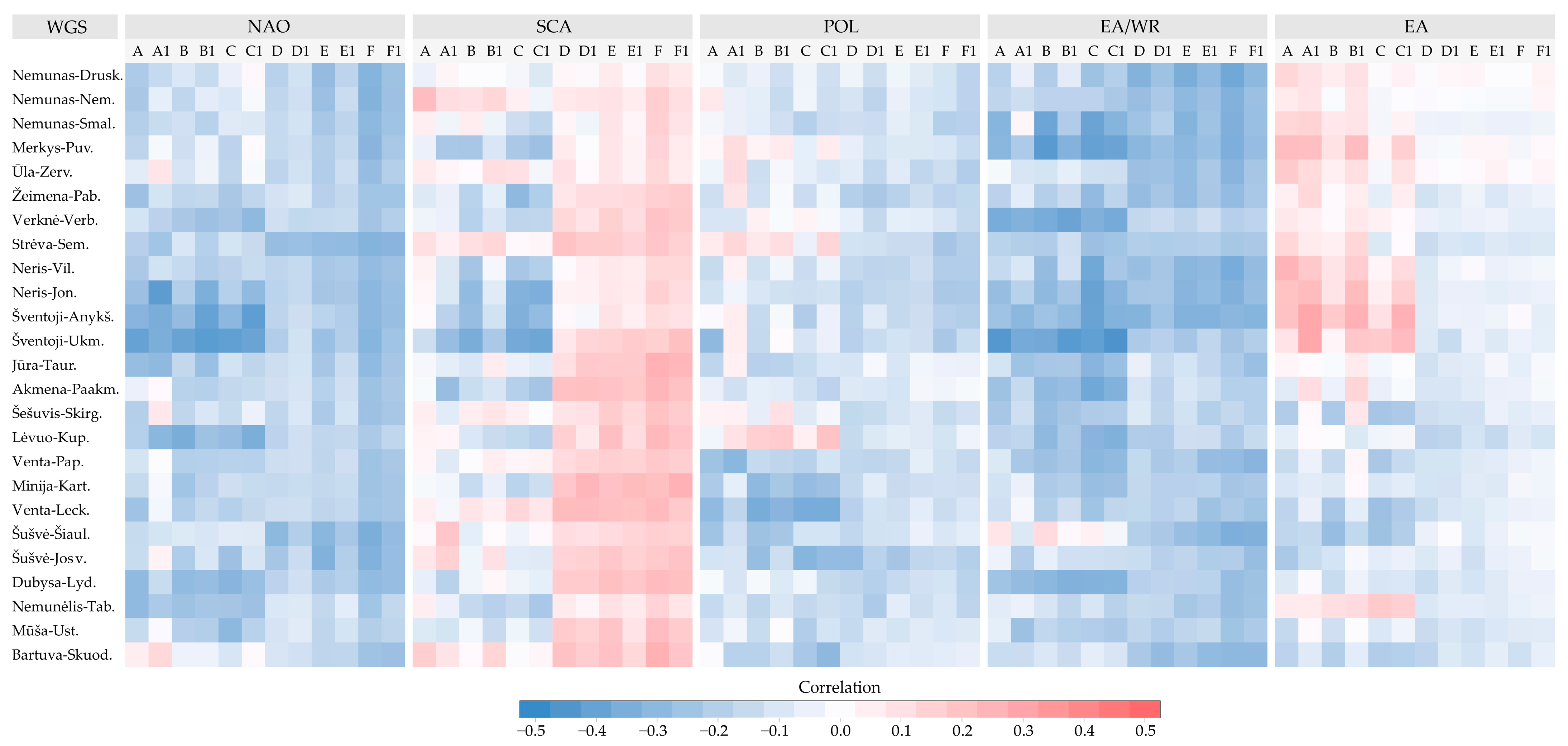
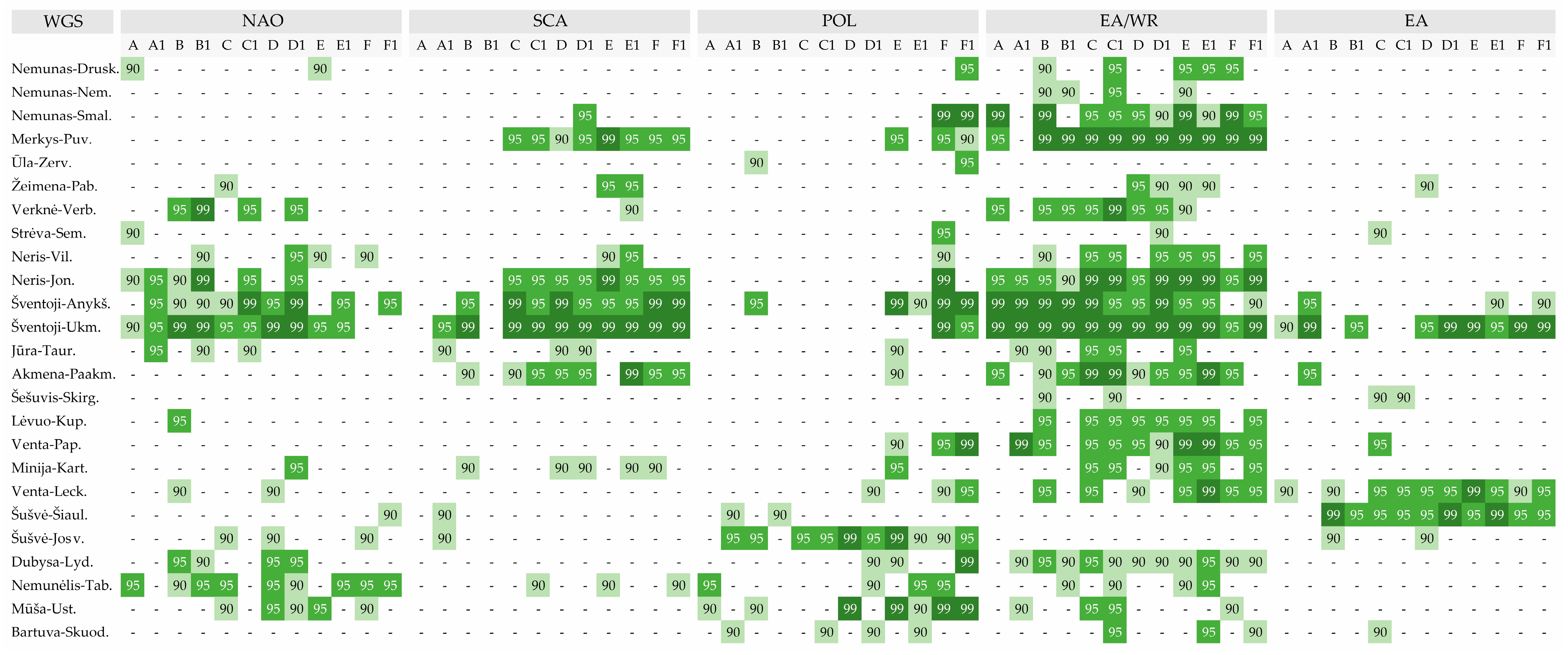

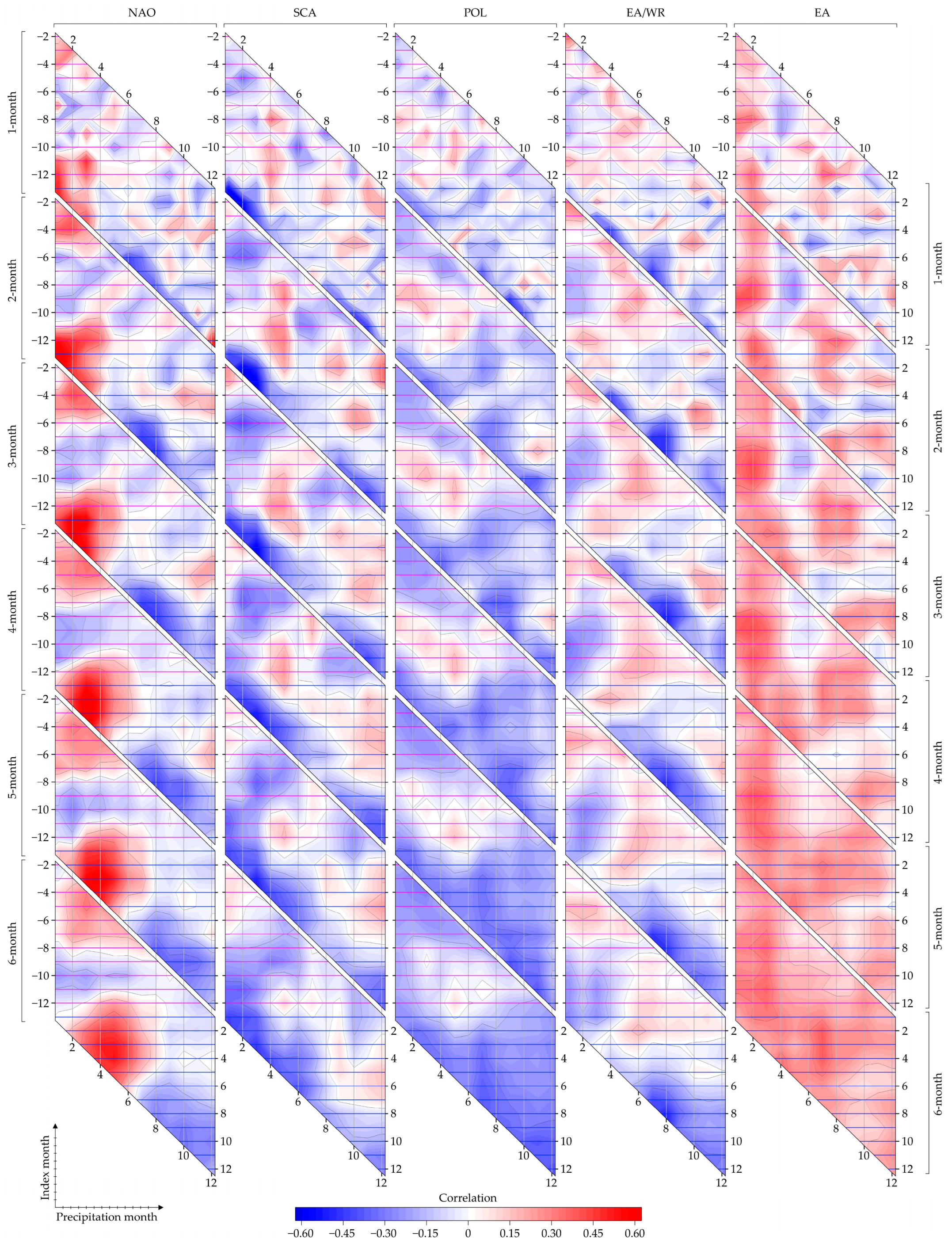
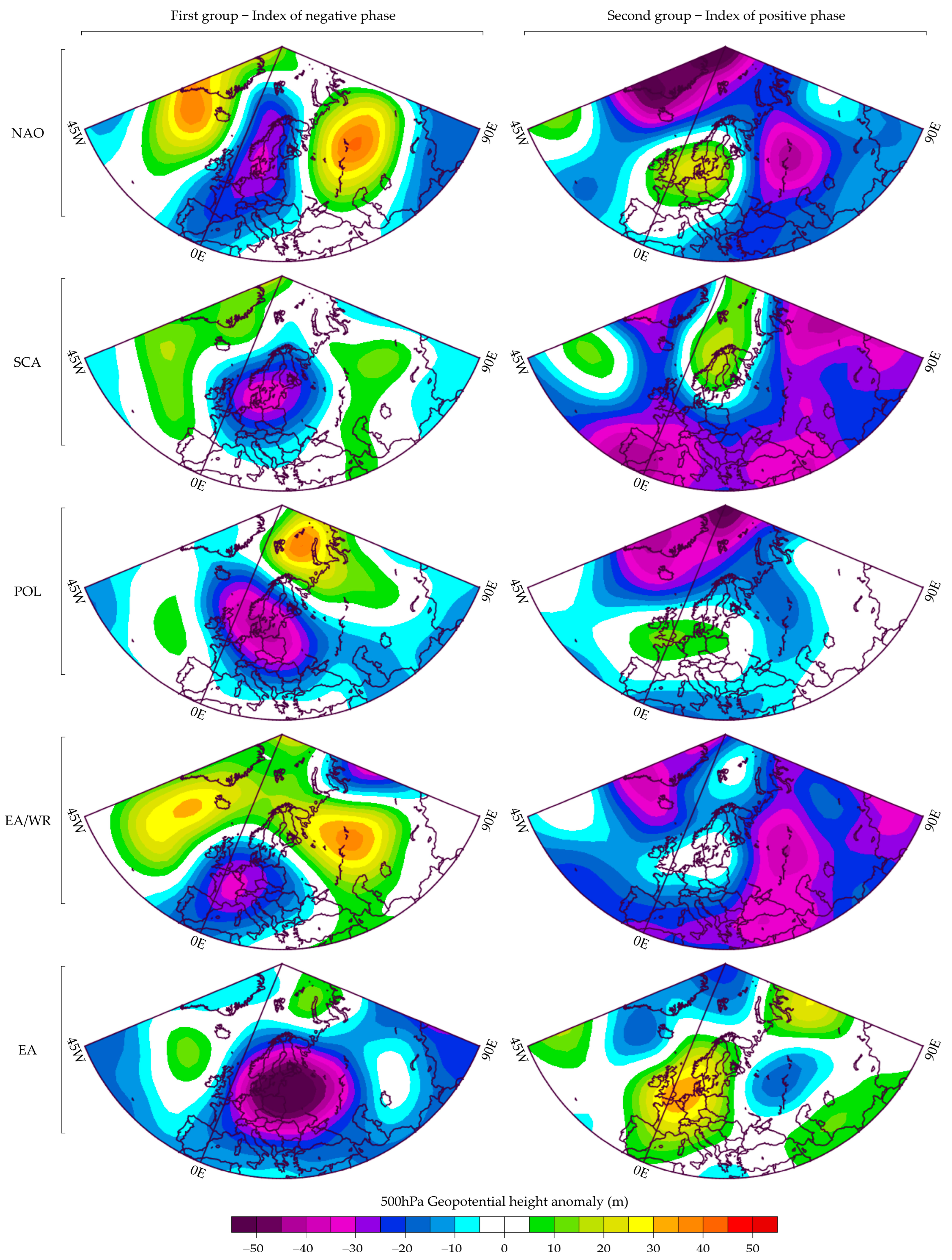
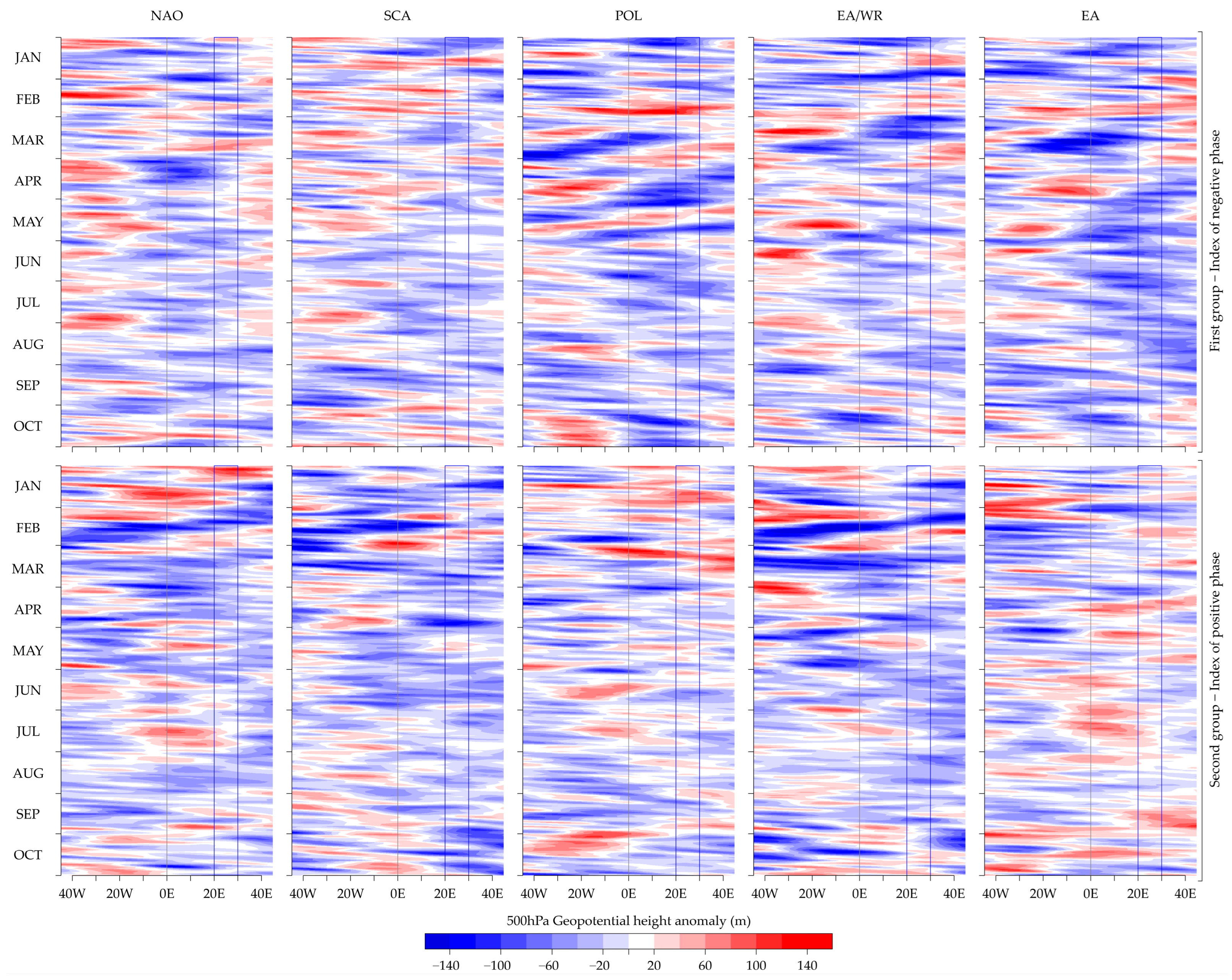
Disclaimer/Publisher’s Note: The statements, opinions and data contained in all publications are solely those of the individual author(s) and contributor(s) and not of MDPI and/or the editor(s). MDPI and/or the editor(s) disclaim responsibility for any injury to people or property resulting from any ideas, methods, instructions or products referred to in the content. |
© 2023 by the authors. Licensee MDPI, Basel, Switzerland. This article is an open access article distributed under the terms and conditions of the Creative Commons Attribution (CC BY) license (https://creativecommons.org/licenses/by/4.0/).
Share and Cite
Gurjazkaitė, K.; Akstinas, V.; Meilutytė-Lukauskienė, D. Effect of Teleconnection Patterns on the Formation of Potential Ecological Flow Variables in Lowland Rivers. Water 2024, 16, 66. https://doi.org/10.3390/w16010066
Gurjazkaitė K, Akstinas V, Meilutytė-Lukauskienė D. Effect of Teleconnection Patterns on the Formation of Potential Ecological Flow Variables in Lowland Rivers. Water. 2024; 16(1):66. https://doi.org/10.3390/w16010066
Chicago/Turabian StyleGurjazkaitė, Karolina, Vytautas Akstinas, and Diana Meilutytė-Lukauskienė. 2024. "Effect of Teleconnection Patterns on the Formation of Potential Ecological Flow Variables in Lowland Rivers" Water 16, no. 1: 66. https://doi.org/10.3390/w16010066
APA StyleGurjazkaitė, K., Akstinas, V., & Meilutytė-Lukauskienė, D. (2024). Effect of Teleconnection Patterns on the Formation of Potential Ecological Flow Variables in Lowland Rivers. Water, 16(1), 66. https://doi.org/10.3390/w16010066








